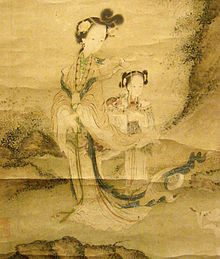

TYPE: Goddess of longevity
ORIGIN: Taoist (Chinese)
KNOWN PERIOD OF WORSHIP: From prehistoric times until present
SYNONYMS: Xi Wang Mu
CENTER(S) OF CULT: Throughout Chinese culture
ART REFERENCES: Paintings and sculptures
LITERARY SOURCES: Various philosophic and religious texts, mostly inadequately researched and untranslated.
INFORMATION: One of the oldest deities known in China, she may have originated as a plague goddess depicted with feline fangs and tail. Under Taoism she became more benign in nature, identified as both governing the length of mortal life and granting the boon of longevity and, in some instances, immortality. Her home is in the western Chinese K'un Lun mountains or, alternatively, in the Hindukush, where she is accompanied by five jade ladies. According to tradition she visited the earth on two occasions, once in 985 BCE to the emperor Mu, and again in the second century BCE to the emperor Wu Ti.
She is the ruler of the west and is associated with the autumn, the season of old age. She is also identified in some texts as the golden mother of the tortoise, the animal which embodies the universe but which is also the dark warrior symbolizing winter and death. Her sacred animal is the crane, which is the Chinese symbol of longevity (It is often incorporated into funeral rituals). She is also said to be represented by the mythical phoenix.